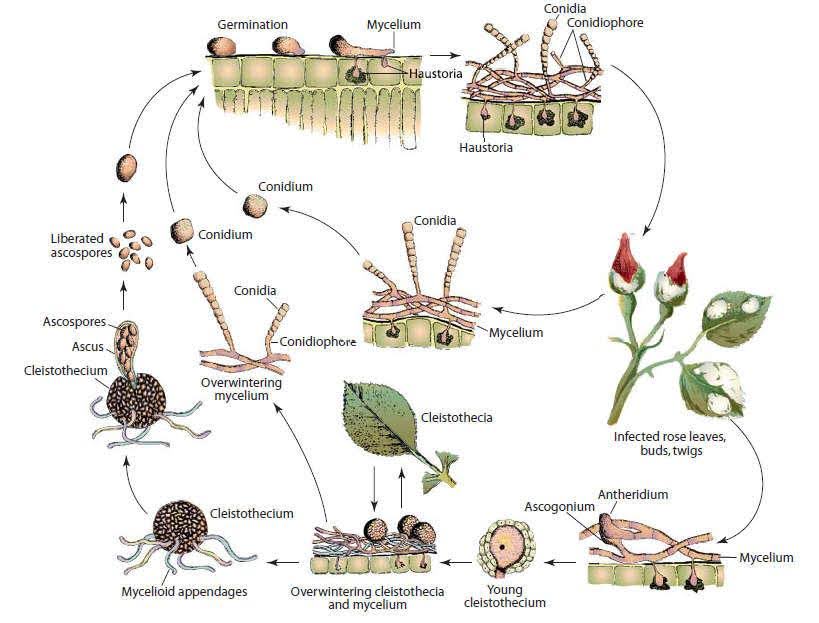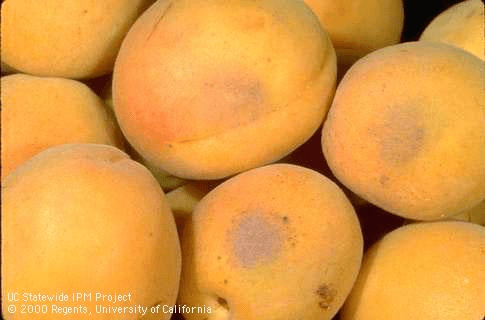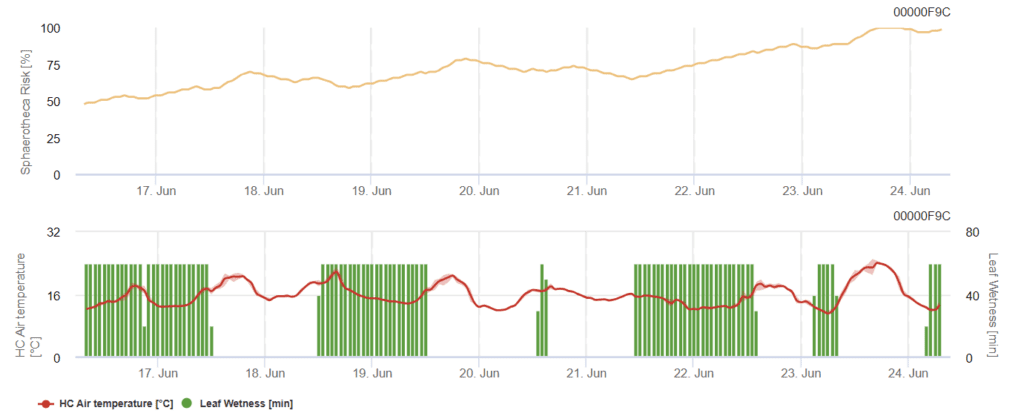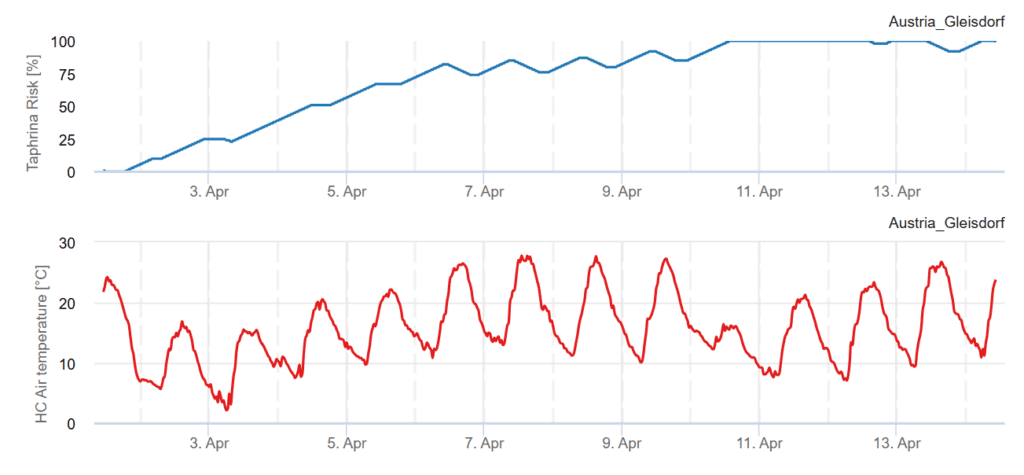
Nectarine and peach disease models
Sphaerotheca pannosa
Pathogen

The pathogen is Sphaerotheca pannosa. It overwinters as mycelia in infected buds or cleistothecia and they serve as the primary inoculum.
Conidia (asexual spores) and ascospores (sexual spores) are produced by mycelium and cleistothecium, respectively. They are carried by wind to susceptible plants and once landing, they germinate and produce a germ tube which forms hyphae, spreading the infection. Secondary infections occur mainly via conidia. Those produced by primary and subsequent infections are carried by wind and rain, continuing the infection. Once environmental conditions become harsh, the fungus shifts to sexual reproduction mainly and the cycle repeats.
Symptoms

Initially, blisters appear on the affected areas, which are soon covered with white to grayish powdery mycelium and spores. This fungal infection leads to leaf distortion, curling, and premature leaf fall. Buds and flowers are also vulnerable; they may fail to open properly and exhibit discoloration and stunted growth. Additionally, fruits are highly susceptible – they may develop rough, corky spots that turn pink to dark brown on their skin and the epicarp gets leathery and hard.
FieldClimate model
General Sphaerotheca pannosa Risk Model

Sensors needed:
- Air temperature
- Leaf wetness
The model considers air temperatures and leaf wetness duration to calculate the risk. The optimum temperature ranges from 21 to 27’c and the disease development gets slower at temperatures above 28’c. Since spores and mycelium are sensitive to extreme heat and direct sunlight, warm moderate temperatures, and shade are generally favorable. No moisture is required for the fungus to establish and grow after infection. Many more conidia are formed in dry conditions than in humid. A value exceeding 60% indicates a high risk of infection, and plant protection measurements should be considered.
Literature
- Domínguez-Serrano, D., García-Velasco, R., Mora-Herrera, M. E., Salgado-Siclan, M. L., & Gonzalez-Diaz, J. G. (2016). The rose powdery mildew (Podosphaera pannosa). Agrociencia, 50(7), 901-917.
- Mulbrhan, A., Brikity, A., Yohana, S. R., & Danish, S. (2016). Survey of Disease Incidence and Severity of Powdery Mildews on Roses (Rosa Sinensis L.) in Greenhouses in Maisirwa, Eritrea. Asian Journal of Science and Technology, 7(5), 2850-2856.
- Ram, V., & Bhardwaj, L. N. (2004). Stone fruit diseases and their management. In Diseases of Fruits and Vegetables: Volume II: Diagnosis and Management (pp. 485-510). Dordrecht: Springer Netherlands.
- Yarwood, C. E., Sidky, S., Cohen, M. O. R. R. I. S., & Santilli, V. I. N. C. E. N. T. (1954). Temperature relations of powdery miluews. https://ipm.ucanr.edu/home-and-landscape/powdery-mildew-on-fruits-and-berries/pest-notes
Monilinia fructicola
Pathogen
The brown rot pathogen, Monilinia fructicola, affects peaches and nectarines through a lifecycle that begins with overwintering in mummified fruits and twig cankers. As temperatures rise in spring, the fungus produces spores that infect blossoms and young shoots, leading to blossom blight and twig cankers. These infections serve as sources of inoculum for fruit infections later in the season. Mature fruits become increasingly susceptible to brown rot, especially under warm, wet, or humid conditions, which favor rapid disease progression. Injuries to fruit, such as those caused by insects or hail, further increase susceptibility. Effective management includes cultural practices like removing mummified fruits and cankered twigs, as well as chemical controls involving fungicide applications during critical periods of bloom and pre-harvest.
Symptoms
Monilinia fructicola manifests through several distinct symptoms. During spring, infected blossoms wilt, turn brown, and may become covered with grayish-tan spore masses, often remaining attached to twigs and serving as sources of secondary inoculum. The infection can extend into twigs, leading to the formation of small, gummy cankers that may girdle and kill the affected shoots. On ripening fruit, initial symptoms appear as small, circular brown spots that rapidly enlarge under favorable conditions, potentially causing the entire fruit to rot within two days. These rotting areas often develop tan to gray spore masses. Affected fruits typically shrivel, turn brown to black, and may either drop to the ground or remain mummified on the tree, contributing to the disease’s persistence and spread.
FieldClimate Model

Sensors needed:
- Air temperature
- Leaf wetness
The curve at 100% indicates optimal conditions for a Monilia infection in orchards. The calculations are based on leaf wetness, temperature and relative humidity. Monilia spp. is well adapted to relatively low temperatures during spring and causes infections at temperatures as low as 5°C within a very short period of wetness duration. 100% infection on the graph indicates optimal conditions for the fungus to enter the plant tissue and cause infections. Curative plant protection measurements have to be taken into account.
Literature
- Peter, K. A. (2024, June 19). Stone fruit disease – Brown rot. Penn State Extension. https://extension.psu.edu/stone-fruit-disease-brown-rot
- Biggs, A. R. (2016). Brown rot of stone fruits. Ohioline, Ohio State University Extension. https://ohioline.osu.edu/factsheet/plpath-fru-29
Leaf curl
Pathogen
Taphrina deformans, the causative agent of peach leaf curl, overwinters as spores on tree surfaces, including bark and bud scales. In early spring, during bud swell and opening, these spores germinate and infect emerging leaves. Cool, wet weather conditions, particularly warm temperatures accompanied by moisture from rain, dew, or irrigation, are optimal for infection. Conversely, dry weather during bud swell and bud break limits disease occurrence. As leaves mature, they become less susceptible to infection, and secondary infections are rare. The fungus produces spores on infected leaf surfaces, which are dispersed by rain or wind, lodging in bark crevices and bud scales to overwinter and perpetuate the disease cycle in subsequent seasons.
Symptoms
The pathogen induces a range of symptoms in peaches and nectarines. Infected leaves emerge in spring displaying thickening, curling, and distortion, often accompanied by reddish or purple discoloration. As the disease progresses, these leaves may turn yellow or brown and eventually fall prematurely, leading to potential defoliation. Infected shoots can become swollen, stunted, and may die, particularly if the infection is severe. Fruit symptoms include raised, irregular, rough patches, often reddish in color, which can cause premature fruit drop or render the fruit unmarketable. If left unmanaged, repeated infections can weaken the tree, reducing fruit yield and overall vigor.
FieldClimate Model

Sensors needed:
- Air temperature
The graph shows risky periods, based on temperature during that time.The pathogen thrives in temperatures between 16 and 27 °C. The graph indicates at 100% that optimal temperatures were met for enough time for an infection event of the pathogen.
Literature
- Biggs, A. R. (2016). Peach leaf curl. Ohioline, Ohio State University Extension. https://ohioline.osu.edu/factsheet/plpath-fru-26
- University of California Agriculture and Natural Resources. (n.d.). Peach leaf curl. UC IPM Pest Notes. Retrieved March 6, 2025, from https://ipm.ucanr.edu/home-and-landscape/peach-leaf-curl/pest-notes/
Scab
Pathogen
Cladosporium carpophilum, the causative agent of peach scab, primarily overwinters as mycelium in twig lesions on the previous season’s shoots. In the spring, when humidity exceeds 70%, the fungus produces conidia (asexual spores) in these lesions. These spores are disseminated by air movement and splashing water, infecting developing fruits, new shoots, and leaves. Optimal conditions for spore germination and fungal growth occur at temperatures between 18°C and 24°C (65°F to 75°F), with rain and high humidity facilitating infection. Notably, there is a prolonged incubation period of approximately 40 to 70 days before symptoms become visible on the fruit.
Symptoms
The disease manifests as small, olive to black, velvety spots on the fruit, often more severe near the stem end. These lesions can coalesce, leading to larger diseased areas and potential fruit cracking. On twigs and shoots, infections appear as slightly raised, round to oval, brown lesions with purple margins later in the season. While leaf infections are less common, they can occur under favorable conditions. Severe infections may result in reduced fruit quality and yield, underscoring the importance of effective management practices.
FieldClimate Model

Sensors needed:
- Air temperatures
- Leaf wetness
The risk of a Cladosporium carpophilum infection is determined by wet conditions during spring and early summer after petal fall. The disease is usually more serious in low- lying, shady and moist areas with low air movement. Infection curves increase during leaf wetness periods within a temperature range of 7 to 24°C and at a risk of 100% optimal conditions for the fungus to enter the plant tissue have been given. Curative plant protection measurements should be considered after 100% risk.
Literature
- Ellis, M. A. (2016). Scab of peach, nectarine, plum, and apricot. Ohioline. Retrieved from https://ohioline.osu.edu/factsheet/plpath-fru-39
- Garofalo, E. (2020). Peach scab. New England Tree Fruit Management Guide. Retrieved from https://netreefruit.org/stone-fruit/peaches-nectarines/diseases/peach-scab
Recommended equipment
Check which sensor set is needed for monitoring this crop’s potential diseases.
